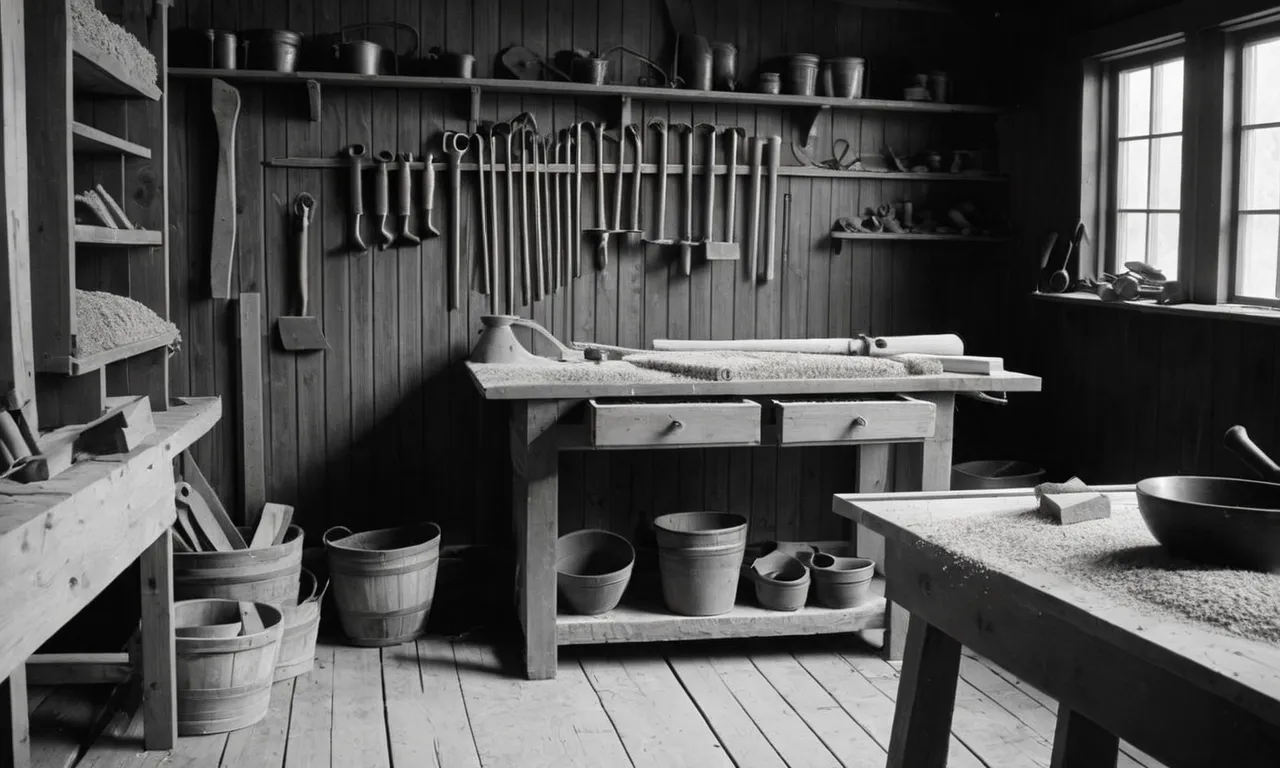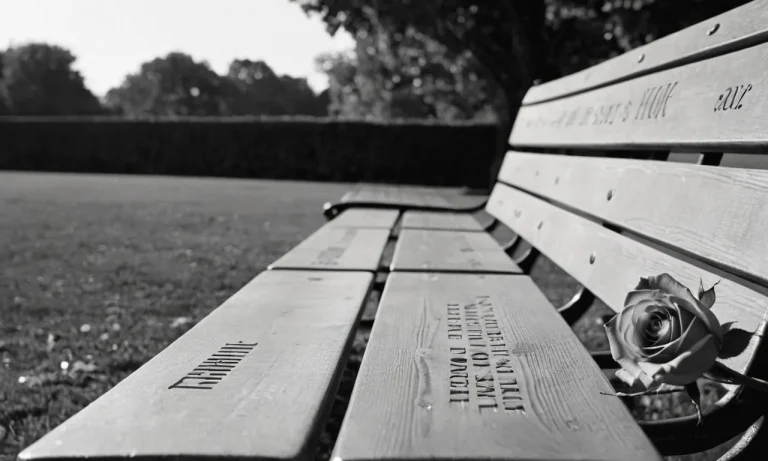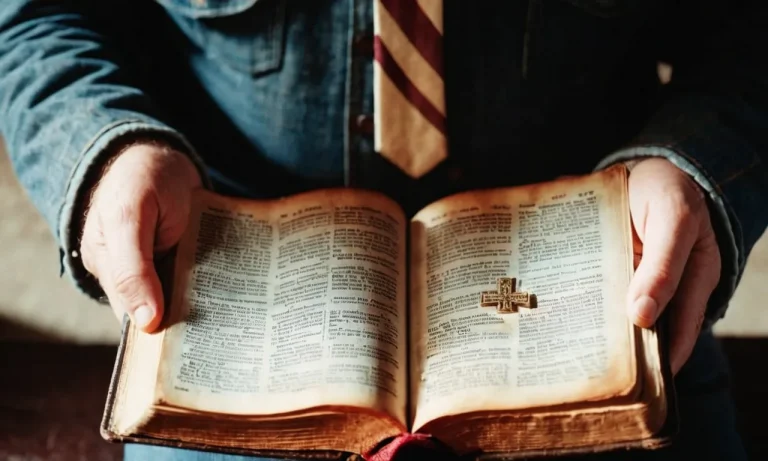How Did Jesus Live? A Look At His Daily Life And Routines
The life of Jesus Christ has fascinated people for over 2000 years. Even today, many wonder what Jesus’ daily life was like when He walked the earth. If you’re short on time, here’s a quick answer to your question: Jesus lived a modest life, dedicated to serving God and spreading His teachings.
He traveled extensively, faced persecution, and spent time with the poor and outcast.
In this approximately 3000 word article, we will take an in-depth look at the daily routines and lifestyle of Jesus during His earthly ministry, examining key details about where He lived, what He wore, what He ate, how He spent His time, the people He interacted with, and the travels He undertook to share God’s message.
Where Did Jesus Live?
Jesus Was Born in Bethlehem
Jesus was born in Bethlehem, a small village about six miles southwest of Jerusalem. According to the Gospels, Jesus’ mother Mary was living in Nazareth and was traveling to Bethlehem with Joseph to take part in a census when she gave birth to Jesus in a stable or cave.
This fulfilled a prophecy that the Messiah would be born in Bethlehem.
Bethlehem was known as the “city of David” and was the hometown of King David. The name Bethlehem means “house of bread” in Hebrew. Though it was a small, seemingly insignificant village, its lineage back to King David gave it great meaning for the Jews who were anticipating the Messiah’s birth there.
He Grew Up in Nazareth
After Jesus was born, Joseph and Mary raised him in Nazareth, a Galilean village about 70 miles north of Bethlehem. The Gospels do not record much about Jesus’ childhood and youth in Nazareth. It seems he lived a normal life learning the trade of carpentry from Joseph and observing Jewish customs with his family.
As an adult, Jesus was often known as “Jesus of Nazareth.” Nazareth was an insignificant village not mentioned in the Old Testament, and some wondered if anything good could come out of such an obscure place. Yet this was where the Son of God spent most of his earthly life prior to his ministry.
He Had No Permanent Home During His Ministry
When Jesus began his public ministry around the age of 30, he left Nazareth and became an itinerant preacher. He traveled from town to town, village to village, proclaiming the kingdom of God. Jesus said, “Foxes have holes and birds of the air have nests, but the Son of Man has no place to lay his head” (Luke 9:58).
He depended on the hospitality of others for food, lodging, and other needs.
Jesus centered his ministry in Galilee, particularly around the Sea of Galilee. He often taught crowds and preached sermons from mountainsides or beaches along the sea. Though he visited Jerusalem, he spent little time there until his final week at Passover when he was crucified.
So while Jesus was born in Bethlehem and raised in Nazareth, he led an on-the-go, transient lifestyle during his three-year public ministry. His lack of a permanent home illustrates his complete devotion to God’s Kingdom and dependence on the Father.
What Did Jesus Wear?
Jesus likely wore simple garments that were common for Jewish men in 1st century Galilee and Judea. As an itinerant preacher and healer, Jesus traveled extensively, so his clothing would have been durable and practical for walking many miles.
Jesus Likely Wore Simple Garments
The gospels describe Jesus’ clothing simply as a tunic (chiton in Greek). A tunic was like a long shirt, usually made of two rectangular pieces of linen or woolen cloth sewn together. Tunics had an opening for the head and arm holes. Most tunics extended to the knees or below.
Men often wore a belt or girdle around the tunic.
Jesus probably wore sandals on his feet. Shoes were rare and sandals made of leather or woven rushes were common footwear. To protect against cold weather, Jesus may have worn a tallit – a woolen outer cloak with tassels (tzitzit) at the corners.
As a rabbi and religious teacher, Jesus likely wore tzitzit on his tunic in obedience to Numbers 15:37-41. These tassels served as reminders of God’s commandments.
The gospels record instances of Jesus wearing finer garments, like the seamless tunic given by soldiers at his crucifixion (John 19:23-24). But his daily attire was humble as befitting his message of spiritual over material priorities.
He May Have Worn a Tallit or Prayer Shawl
Jesus, being an observant Jew, would likely have worn a tallit during prayer. A tallit was a rectangular garment with tassels or tzitzit attached. Jesus criticized hypocrites who lengthened their tassels for show (Matthew 23:5). So his tallit tassels were probably a modest size.
A tallit was draped over the head and shoulders during prayer. This may explain why a woman could approach Jesus from behind and touch the hem of his garment (Luke 8:43-44). She likely touched his tallit tassel.
When mocked by soldiers, the Gospel of Matthew states they stripped Jesus and “put a scarlet robe on him.” This was likely a military cloak they draped over his shoulders like a tallit. Thus, the soldiers unwittingly dressed Jesus as a king in royal robes and a “crown” of thorns.
Jesus probably wore a basic tallit to avoid ostentation. But he valued the Commandment it represented as he criticized those making them extravagant in size (Matthew 23:5). Jesus focused on inward righteousness rather than outward religious displays.
What Did Jesus Eat?
As an observant Jew living in first century Palestine, Jesus likely followed a modest diet that reflected the customs and food availability of his time. Here’s an overview of what scholars speculate Jesus may have eaten and drunk on a daily basis.
Jesus Ate a Modest Diet
Rather than indulging in lavish feasts enjoyed by the social elite, Jesus most likely ate a simple diet consisting of foods commonly available to the working class, such as vegetables, legumes, whole grains, fish, eggs, and dairy products like milk, cheese and yogurt.
Bread was a dietary staple, and Jesus even used bread as a symbol of God’s provision and essential nourishment when he fed the five thousand. Whole grains like barley, wheat, millet and rice were affordable and accessible.
As a carpenter before beginning his ministry, Jesus expended considerable energy with physical labor. His diet likely reflected these high caloric needs. Vegetables (lentils, beans, peas, squash, olives), fruit (grapes, dates, figs), nuts and seeds provided valuable nutrition.
He Drank Wine in Moderation
In Jesus’s day, wine was safer to drink than water which could be contaminated. As an observant Jew, Jesus would have upheld the Torah’s injunction against excessive drunkenness. Thus he likely drank wine in moderation with meals to quench thirst and provide health benefits.
Wine was also integral to sacred Jewish rituals. During Passover Seder meals, multiple cups of wine were shared, culminating with the cup sealing God’s new covenant. And wine accompanied celebrations like weddings where Jesus famously turned water into fine wine (John 2:1-11).
He May Have Followed Kosher Dietary Laws
The Torah provided ancient Jews with dietary guidelines on foods to avoid and permitted for consumption. While the Gospels don’t specify if Jesus only ate kosher foods, most religious Jews like Jesus attempted to observe Mosaic Law.
Kosher dietary considerations for meat mandated humane slaughter along with complete draining of blood seen as sacred. Permitted land animals included cattle, sheep and goats but excluded pigs and rabbits.
Of sea creatures, Jews could eat finned and scaled fish like tuna or salmon, but shellfish including lobster, shrimp, oysters and clams were forbidden as “unclean.” Fowl permitted under kosher guidelines were chicken, doves and pigeons. Eggs and dairy products like goat milk were also kosher.
How Did Jesus Spend His Time?
Preaching, Teaching & Healing
Jesus spent much of his time during his 3-year ministry preaching about the kingdom of God. He taught in synagogues, on hillsides, and wherever people would gather to hear his message of hope, love and redemption (Matthew 4:23).
His teaching style used simple stories and analogies that connected with common people. The crowds were amazed at his authority and wisdom (Luke 4:32). In addition to preaching, Jesus also demonstrated God’s power by healing all kinds of sickness and diseases.
Huge crowds followed him wherever he went, hoping to be healed or witness one of his miracles (Matthew 4:24-25).
Praying Frequently
Prayer was a regular part of Jesus’s daily routine. The Gospels portray Jesus often slipping away to lonely places to connect with his Heavenly Father through prayer (Mark 1:35). His prayers likely expressed praise, thanksgiving, intercession for others, and requests for strength and guidance.
Through prayer, Jesus found renewal, wisdom and power for the demanding work of ministry. Sometimes he spent whole nights in prayer before major decisions or events (Luke 6:12-13).
Observing the Sabbath
The Gospels record over 15 different Sabbaths when Jesus attended synagogue services. According to Jewish customs, Sabbath observance involved resting from work, reflecting on God’s Word, worshiping, and doing good deeds.
Based on this pattern, it’s likely Jesus also observed other Sabbaths in similar fashion during his ministry. Some of Jesus’s most dramatic healings and teaching took place on the Sabbath (Mark 3:1-6), much to the anger of the religious leaders.
Socializing with Disciples & Outcasts
Jesus invested significant time developing relationships with his 12 disciples and other followers. He traveled with them, ate with them, and used informal settings to further train and equip them for ministry (Mark 9:33-35).
His table fellowship also extended to those rejected by society like tax collectors and sinners, scandalizing the religious elites. For Jesus, meals represented opportunities to build trust through authentic community. By welcoming outcasts, he demonstrated God’s unconditional love and acceptance.
Who Did Jesus Interact With?
His Disciples
Jesus spent most of His time with His twelve disciples, teaching them about the Kingdom of God and training them to continue His work after He was gone. He traveled with them, ate with them, and built close friendships.
According to the Gospels, some of Jesus’ disciples included Peter, James, John, Andrew, Philip, Bartholomew, Matthew, Thomas, James the son of Alphaeus, Thaddaeus, Simon the Zealot, and Judas Iscariot who betrayed Him.
Crowds Who Came to Hear Him
In addition to His small group of disciples, the Gospels record that large crowds often followed Jesus to hear His teaching and witness His miracles. These crowds included men and women, young and old, rich and poor, Jews and some Gentiles.
Though not all believed in Him, many common people responded positively to His message and some called him “rabbi” or teacher. Estimates suggest that 3000-5000 people were fed when Jesus miraculously multiplied the loaves and fish (Matthew 14:13–21).
Social Outcasts
Remarkably, Jesus regularly interacted with those rejected by society – prostitutes, tax collectors, lepers, disabled people, and more. His compassion for outcasts drew criticism from the religious elite who avoided them to maintain ceremonial purity.
But Jesus emphasized spiritual rather than ritual purity and welcomed marginalized groups into God’s Kingdom. His famous Parable of the Good Samaritan makes clear that loving even “neighbors” culturally despised is a non-negotiable aspect of righteousness.
Religious Leaders Who Opposed Him
Jesus also frequently engaged the religious leaders of His day in debate about the meaning of Scripture and God’s priorities. Especially the Pharisees, Sadducees, scribes and teachers of the law opposed His non-traditional, grace-focused teaching.
They plotted against Him, condemned Him for spending time with “sinners,” and eventually arrested Him on trumped up charges. Though some leaders like Nicodemus came to Him in secret, Jesus denounced much religious hypocrisy in public. Still, He asked God to forgive even those who crucified Him.
| Type of People | Examples from Jesus’ Life |
|---|---|
| His Disciples | Peter, James, John etc. |
| Crowds | 3000-5000 at miraculous feedings |
| Social Outcasts | Prostitutes, tax collectors, lepers |
| Opponents | Pharisees, Sadducees, teachers of the law |
To learn more, check out these references:
- https://www.biblestudytools.com – Bible history and context
- https://www.history.com – Secular historical information
Where Did Jesus Travel?
Towns & Villages in Galilee
Jesus spent most of his life and ministry in the region of Galilee, traveling between the towns and villages located there. Some of the places Jesus frequently visited in Galilee included:
- Nazareth – Jesus grew up in this small village which was likely his home base during his ministry travels. He was known as “Jesus of Nazareth.”
- Capernaum – Situated on the Sea of Galilee, Capernaum was where Jesus called home for his Galilean ministry. He performed many miracles and teachings here.
- Cana – Jesus attended a wedding feast in this town where he famously turned water into wine, his first public miracle.
- Nain – Jesus raised a widow’s son in this town, one of his greatest miracles.
- Sea of Galilee – Jesus spent a great deal of time traveling and teaching in the towns and beaches surrounding the Sea of Galilee.
- Mount of Beatitudes – A hill near Capernaum where Jesus preached the Sermon on the Mount to crowds.
Jesus walked extensively between towns and villages all over the Galilee region, preaching in synagogues, family homes, fields, hillsides, and other locations.
Judea and Areas Near Jerusalem
In the later part of his ministry, Jesus expanded his travels to Judea which contains Jerusalem and the surrounding areas. Some of the notable places Jesus visited here include:
- Jerusalem – Jesus traveled here often for Jewish festivals like Passover and frequently taught at the Temple.
- Bethany – A town near Jerusalem where Jesus stayed with his friends Mary, Martha, and Lazarus.
- Bethphage – Jesus began his triumphal entry into Jerusalem from this small town on Palm Sunday.
- Jericho – An ancient city with a famous sycamore tree that a tax collector named Zacchaeus climbed to catch a glimpse of Jesus.
- Emmaus – Jesus appeared to two disciples on the road to this town after his resurrection.
In the Judea region, Jesus visited towns, villages, and the bustling city of Jerusalem mostly during major Jewish festivals.
Possible Travel Beyond Israel
There is no definitive biblical evidence that Jesus traveled outside of Israel and its immediately surrounding regions. However, some scholars believe Jesus may have journeyed to other locations in his younger pre-ministry years. Possible places include:
- Egypt – Jesus may have fled here as a young child with Joseph and Mary to escape Herod’s massacre of infants.
- Persia and Babylon – Some theories suggest Jesus traveled with Joseph on trade routes to these eastern empires, exposing Jesus to Zoroastrianism.
- India – A small number of scholars believe Jesus may have studied Buddhism in India during his “lost years.” But there is scarce evidence for this theory.
- Britain – Highly speculative legends propose Jesus may have traveled to Britain with Joseph of Arimathea as a tin merchant. This idea lacks historical support.
While not impossible, there is weak scholarly evidence that Jesus ever traveled beyond the bounds of Israel and the Middle East during his lifetime. The majority of Jesus’ ministry took place within Galilee and Judea according to the biblical accounts.
Conclusion
In summary, while Jesus lived a modest life with no permanent home, His days were filled with carrying out His important spiritual mission. Through His teachings, travels, interactions, and time spent in prayer and observance, Jesus shared a powerful message of love, redemption and hope that changed the world forever.








